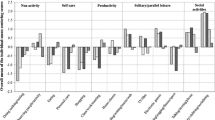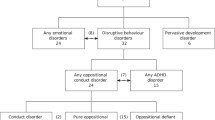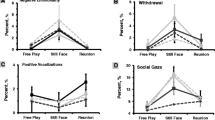Abstract
The present study examines whether children display different frequencies of behaviors at birthday party as compared to non-birthday party settings, and elucidates in which setting behavior is more predictive of later child functioning. Behavior in birthday and non-birthday contexts was examined at 12 and 24 months of age for 56 children with autism spectrum disorder (ASD). The results of this study indicate that context does matter for young children’s behavior and leads to a different picture of behavioral functioning. For children with ASD, behaviors from non-birthday videotapes are more predictive of functioning later in childhood. The findings suggest that close attention must be paid to contextual factors that may influence young children’s behavior.
Similar content being viewed by others
References
Adrien, J. L., Lenoir, P., Martineau, J., Perrot, A., Hameury, L., Larmande, C., & Sauvage, D. (1993). Blind ratings of early symptoms of autism based upon family home movies. Journal of the American Academy of Child and Adolescent Psychiatry, 32, 617–626.
Baranek, G. T. (1999). Autism during infancy: A retrospective video analysis of sensory-motor and social behaviors at 9–12 months of age. Journal of Autism and Developmental Disorders, 29, 213–224.
Charman, T., Baron-Cohen, S., Sweetenham, J., Baird, G., Drew, A., & Cox, A. (2003). Predicting language outcome in infants with autism and pervasive developmental disorder. International Journal of Language and Communication Disorders, 38, 265–285.
Clark, P., & Rutter, M. (1981). Autistic children’s responses to structure and to interpersonal demands. Journal of Autism and Developmental Disorders, 11, 201–217.
Cox, A., Klein, K., Charman, T., Baird, G., Baron-Cohen, S., Swettenham, J., Wheelwright, S., & Drew, A. (1999). Autism spectrum disorders at 20 and 42 months of age: Stability of clinical and ADI-R diagnosis. Journal of Child Psychology and Psychiatry, 40, 719–732.
Crais, E. R., Watson, L. R., Baranek, G. T., & Reznick, J. S. (2006). Early identification of autism: How early can we go? Seminars in Speech and Language. Special Issue: Current Issues in Providing Services to Infants and Toddlers, 27, 143–160.
Dawson, G., & Lewy, A. (1989). Arousal, attention, and the socioemotional impairments of individuals with autism. In G. Dawson (Ed.), Autism: Nature, diagnosis, and treatment (pp. 51–84). New York, NY: Guilford Press.
Filipek, P. A., Accardo, P. J., Ashwal, S., Baranek, G. T., Cook, E. H. Jr., Dawson, G., Gordon, B., Gravel, J. S., Johnson, C. P., Kallen, R. J., Levy, S. E., Minshew, N. J., Ozonoff, S., Prizant, B. M., Rapin, I., Rogers, S. J., Stone, W. L., Teplin, S. W., Tuchman, R. F., & Volkmar, F. R. (2000). Practice parameter: Screening and diagnosis of autism: Report of the Quality Standards Subcommittee of the American Academy of Neurology and the Child Neurology Society. Neurology, 55, 468–479.
Hoshino, Y., Kaneko, M., Yashima, Y., Kumashiro, H., Volkmar, F. R., & Cohen, D. J. (1987). Clinical features of autistic children with setback course in their infancy. Japanese Journal of Psychiatry and Neurology, 41, 237–245.
Landa, R., & Garrett-Mayer, E. (2006). Development in infants with autism spectrum disorders: A prospective study. Journal of Child Psychology and Psychiatry, 47, 629–638.
Landry, S., & Loveland, K. (1989). The effect of social context on the functional communication skills of autistic children. Journal of Autism and Developmental Disorders, 19, 283–299.
Lewy, A., & Dawson, G. (1992). Social stimulation and joint attention in young autistic children. Journal of Abnormal Child Psychology, 20, 555–566.
Lord, C., Rutter, M., DiLavore, P. C., & Risi, S. (1999). The autism diagnostic observation schedule—generic. Los Angeles: Western Psychological Services.
Maestro, S., Casella, C., Milone, A., Muratori, F., & Palacio-Espasa, F. (1999). Study of the onset of autism through home movies. Psychopathology, 32, 292–300.
Maestro, S., Muratori, F., Barbieri, F., Casella, C., Cattaneo, V., Cavallaro, M. C., Cesari, A., Milone, A., Rizzo, L., Viglione, V., Stern, D., & Palacio-Espasa, F. (2001). Early behavioral development in autistic children: The first 2 years of life through home movies. Psychopathology, 34, 147–152.
Maestro, S., Muratori, F., Cavallaro, M. C., Pei, F., Stern, D., Golse, B., & Palacio-Espasa, F. (2002). Attentional skills during the first 6 months of age in autism spectrum disorder. Journal of the American Academy of Child and Adolescent Psychiatry, 11, 1239–1245.
Maestro, S., Muratori, F., Cesari, A., Cavallaro, M. C., Paziente, A., Pecini, C., Grassi, C., Manfredi, A., & Sommario, C. (2005a). Course of Autism signs in the first year of life. Psychopathology, 38, 26–31.
Maestro, S., Muratori, F., Cesari, A., Cavallaro, M. C., Pecini, C., Cesari, A., Paziente, A, Stern, D., Golse, B., & Palacio-Espasa, F. (2005b). How young children treat objects and people: An empirical study of the first year of life in autism. Child Psychiatry & Human Development, 35, 383–396.
Maestro, S., Muratori, F., Cesari, A., Pecini, C., Apicella, F., & Stern, D. (2006). A view to regressive autism through home movies. Is early development really normal? Acta Psychiatrica Scandinavica, 113, 68–72.
Mars, A. E., Mauk, J. E., & Dowrick, P. (1998). Symptoms of pervasive developmental disorders as observed in prediagnostic home movies of infants and toddlers. Journal of Pediatrics, 132, 500–504.
Mitchell, S., Brian, J., Zwaigenbaum, L., Roberts, W., Szatmari, P., Smith, I., & Bryson, S. (2006). Early language and communication development of infants later diagnosed with autism spectrum disorder. Journal of Developmental and Behavioral Pediatrics, 27, S69–S78.
Mullen, E. M. (1995). Mullen scales of early learning. Circle Pines: American Guidance Service.
Osterling, J., & Dawson, G. (1994). Early recognition of children with autism: A study of first birthday home video videotapes. Journal of Autism and Developmental Disorders, 24, 247–257.
Osterling, J. A., Dawson, G., & Munson, J. A. (2002). Early recognition of 1-year-old infants with autism spectrum disorder versus mental retardation. Development and Psychopathology, 14, 239–251.
Receveur, C., Lenoir, P., Desombre, H., Roux, S., Barthelemy, C., & Malvy, J. (2005). Interaction and imitation deficits from infancy to 4 years of age in children with autism: A pilot study based on videotapes. Autism, 9, 69–82.
Rogers, S. J., & Ozonoff, S. (2005). Annotation: What do we know about sensory dysfunction in autism? A critical review of the empirical evidence. Journal of Child Psychology and Psychiatry, 46, 1255–1268.
Rutter, M. D., Le Couteur, A., & Lord, C. (2003). Autism diagnostic interview—Revised. Los Angeles: Western Psychological Services.
Sparrow, S., Balla, D., & Cicchetti, D. (1984). Vineland adaptive behavior scales. Circle Pines: American Guidance Service.
Thorndike, R. L., Hagan, E. P., & Sattler, J. M. (1986). Guide for administering and scoring for the fourth edition: Stanford-Binet Intelligence Scale. Chicago: Riverside.
Waterhouse, L., Fein, D., & Modahl, C. (1996). Neurofunctional mechanisms in autism. Psychological Review, 103, 457–489.
Werner, E., & Dawson, G. (2005). Validation of the phenomenon of autistic regression using home videotapes. Archives of General Psychiatry, 62, 889–895.
Werner, E., Dawson, G., Osterling, J., & Dinno, N. (2000). Brief report: recognition of autism spectrum disorder before one year of age: A retrospective study based on home videotapes. Journal of. Autism Developmental. Disorders. 30, 157–162.
Williams, D. (1994). Somebody somewhere. New York: Doubleday.
Woods, J. J., & Wetherby, A. M. (2003). Early identification of and intervention for infants and toddlers who are at risk for autism spectrum disorder. Language, Speech, and Hearing in Schools, 34, 180–193.
Acknowledgments
This study was supported by a grant from the National Institute of Child Health and Human Development (NICHD), HD 35458, M.A. Spence, P.I. This project was conducted under the auspices of the Collaborative Programs of Excellence in Autism network. We gratefully acknowledge the contributions made by Kelly Jarvis to the coding of the videotapes and many other aspects of the project. We thank Professor Carol Whalen for her comments and suggestions. We also thank the children and parents who participated in this study.
Author information
Authors and Affiliations
Corresponding author
Rights and permissions
About this article
Cite this article
Thorsen, K.L., Goldberg, W.A., Osann, K. et al. Birthday and Non-birthday Videotapes: The Importance of Context for the Behavior of Young Children with Autism. J Autism Dev Disord 38, 1047–1058 (2008). https://doi.org/10.1007/s10803-007-0479-9
Received:
Accepted:
Published:
Issue Date:
DOI: https://doi.org/10.1007/s10803-007-0479-9




